Expanse, which lets its customers know when their digital assets aren’t safe, has raised $70 million in new funding
Expanse, a six-year-old, San Francisco-based company that helps its clients understand and monitor what it calls their “global internet attack surface,” has received a $70 million vote of confidence from its earlier backers, as well as some notable individual investors.
Previous investor TPG Growth led the Series C round, with participation from other earlier investors that include NEA, IVP and Founders Fund. But the company also drew checks directly from Founders Fund co-founder Peter Thiel, Michael Dell, former IBM CEO Sam Palmisano, media entrepreneur Arianna Huffington and Turner Enterprise CEO Taylor Glover.
What do they find so interesting about Expanse, which was formerly known as Qadium? Its traction, for starters. It turns out that when you start indexing global internet protocol addresses before everyone else — meaning the numerical labels assigned to each device connected to a computer network — it’s hard for competitors to catch up.
Indeed, numerous big organizations, including CVS and PayPal, are among others that now use the company’s software-as-a-service to help manage their far-flung digital assets connected to the public internet. According to co-founder and CEO Tim Junio, Expanse has been tripling its sales year over year — and quadrupling the terms of its contracts. Toward that end, he says it now has more than 10 customers that have signed up for $1 million-plus contracts. “VCs like to look at how long it takes to go from $1 million to $10 million in [annual recurring revenue]. It took us 22 months, about as fast as [the now-public cloud-storage company] Box.”
Much of that revenue is also coming from U.S. federal agencies, including the U.S. Army, the U.S. Navy and the U.S. Air Force, as well as the State Department, the Defense Department and the Department of Energy. Collectively, they account for more than $100 million in contracts with Expanse, it says.
Asked if Thiel has played a role in making introductions — Thiel famously advised Donald Trump leading up to his election as president, and Thiel’s former chief of staff, Michael Kratsios, is now the country’s chief technology officer — Junio says that all of Expanse’s investors have helped in making customer introductions and pours water on any suggestion that Thiel has done special favors for the company.
Meanwhile, though the company is known for its work in helping customers identify security risks they don’t know about on their networks — like an IoT device that hasn’t been patched — it’s now going after adjacent problems that are bigger-spend problems, including looking at its customers’ critical suppliers to be sure that they aren’t introducing vulnerabilities, including across their commercial cloud providers and co-hosting facilities.
Eventually, it’s easy to see a day when Expanse sells some of the aggregated data it’s seeing, perhaps on a sector by sector basis, though Junio says that Expanse “isn’t going in that direction” currently. For now, he says, the biggest trend that’s driving the business today is the digital transformation of every type of company, which is resulting in plenty of insecurity. As more businesses move to the cloud, there is always the danger that employees — their own or those acquired through mergers — won’t always know or follow policies, and that they’ll move sensitive data where they should not.
That it’s a trend with no end in sight goes a long way in explaining the momentum of Expanse. Already, the company has 150 employees across offices in San Francisco, Washington, DC, New York and Atlanta. With its newest round — a sum that brings Expanse’s total funding to $135 million altogether — the plan is partly to move into new international markets beyond where it already operates. Those markets include the U.K., Canada, Australia and Japan.
Powered by WPeMatico
Apigee jumps on hybrid bandwagon with new API for hybrid environments
This year at Google Cloud Next, the theme is all about supporting hybrid environments, so it shouldn’t come as a surprise that Apigee, the API company it bought in 2016 for $265 million, is also getting into the act. Today, Apigee announced the beta of Apigee Hybrid, a new product designed for hybrid environments.
Amit Zavery, who recently joined Google Cloud after many years at Oracle, and Nandan Sridhar, describe the new product in a joint blog post as “a new deployment option for the Apigee API management platform that lets you host your runtime anywhere—in your data center or the public cloud of your choice.”
As with Anthos, the company’s approach to hybrid management announced earlier today, the idea is to have a single way to manage your APIs no matter where you choose to run them.
“With Apigee hybrid, you get a single, full-featured API management solution across all your environments, while giving you control over your APIs and the data they expose and ensuring a unified strategy across all APIs in your enterprise,” Zavery and Sridhar wrote in the blog post announcing the new approach.
The announcement is part of an overall strategy by the company to support a customer’s approach to computing across a range of environments, often referred to as hybrid cloud. In the Cloud Native world, the idea is to present a single fabric to manage your deployments, regardless of location.
This appears to be an extension of that idea, which makes sense, given that Google was the first company to develop and open-source Kubernetes, which is at the forefront of containerization and Cloud Native computing. While this isn’t pure Cloud Native computing, it is keeping true to its ethos and it fits in the scope of Google Cloud’s approach to computing in general, especially as it is being defined at this year’s conference.
Powered by WPeMatico
Accenture announces intent to buy French cloud consulting firm
As Google Cloud Next opened today in San Francisco, Accenture announced its intent to acquire Cirruseo, a French cloud consulting firm that specializes in Google Cloud intelligence services. The companies did not share the terms of the deal.
Accenture says that Cirruseo’s strength and deep experience in Google’s cloud-based artificial intelligence solutions should help as Accenture expands its own AI practice. Google TensorFlow and other intelligence solutions are a popular approach to AI and machine learning, and the purchase should help give Accenture a leg up in this area, especially in the French market.
“The addition of Cirruseo would be a significant step forward in our growth strategy in France, bringing a strong team of Google Cloud specialists to Accenture,” Olivier Girard, Accenture’s geographic unit managing director for France and Benelux said in a statement.
With the acquisition, should it pass French regulatory muster, the company would add a team of 100 specialists trained in Google Cloud and G Suite to the an existing team of 2,600 Google specialists worldwide.
The company sees this as a way to enhance its artificial intelligence and machine learning expertise in general, while giving it a much stronger market placement in France in particular and the EU in general.
As the company stated, there are some hurdles before the deal becomes official. “The acquisition requires prior consultation with the relevant works councils and would be subject to customary closing conditions,” Accenture indicated in a statement. Should all that come to pass, then Cirruseo will become part of Accenture.
Powered by WPeMatico
Labelbox raises $10 million for its services to support machine learning applications
Labelbox, a provider of services to create, manage and maintain data sets for machine learning applications, has raised $10 million in a new round of funding.
The financing came from Gradient Ventures, Google’s AI-focused venture fund, with participation from previous investors Kleiner Perkins, First Round Capital and Sumon Sadhu, an angel investor.
Labelbox manages the process of outsourcing data labeling for organizations and provides toolkits for companies or organizations to manage the data they’re receiving and ensuring the quality of that data, according to chief executive Manu Sharma.
For the Labelbox founders — Sharma; Dan Rasmuson, the company’s chief technology officer; and Brian Rieger, the chief operating officer — the tools they developed are simply an extension of the services they’d needed at their previous employers — companies like DroneDeploy, Planet Labs and Boeing.
Financing from the round will be used to double the size of its team from 11 employees to 22, and build out its sales and marketing teams.
Labelbox counts around 50 customers for its service and charges them based on the volume of data that companies upload and the breadth of services they use, Sharma said. Some named customers include FLIR Systems, Lytx, Airbus, Genius Sports and KeepTruckin.
As we’d reported when Labelbox launched from stealth last year, anyone can use the company’s toolkit for free. Companies are charged once they hit a certain usage threshold. Lytx, for instance, uses Labelbox for its DriveCam, a system installed on half a million trucks with cameras that use AI to detect unsafe driver behavior so they can be coached to improve. And the media and publishing giant Conde Nast is using Labelbox to match runway fashion to related items in their archive of content.
“Labelbox substantially reduces model development times and empowers data science teams to build great machine learning applications,” said Sharma in a statement. “With the new funding, Labelbox will continue to double down on bringing data labeling infrastructure to the machine learning teams with powerful automation, collaboration, and enterprise-grade features.”
Gradient Ventures was interested enough in the technology to invest, and sees promise in the company’s ability to support the development of machine learning tools globally.
“Labelbox is well-positioned to fuel the industrialization of machine learning across many sectors, such as manufacturing, transportation and healthcare. In doing so, they will unlock the potential of AI for companies across the globe,” said Anna Patterson, founder and managing partner at Gradient Ventures.
Powered by WPeMatico
Can the law be copyrighted?
UpCodes wants to fix one of the building industry’s biggest headaches by streamlining code compliance. But the Y Combinator-backed startup now faces a copyright lawsuit filed against it by the International Code Council, the nonprofit organization that develops the code used or adopted in building regulations by all 50 states.
The case may have ramifications beyond the building industry, including for compliance technology in other sectors and even individuals who want to reproduce the law. At its core are several important questions: Is it possible to copyright the law or text that carries the weight of law? Because laws and codes are often written by private individuals or groups instead of legislators, what rights do they continue to have over their work? Several relevant cases, including ones involving building codes, have been decided by different circuits in the United States Court of Appeals, which means the UpCodes lawsuit may potentially be heard by the Supreme Court.
Brothers Scott and Garrett Reynolds founded UpCodes in 2016. While working as an architect, Scott says he realized how laborious code compliance is for builders, who are required by law to follow codes that determine things like the height of handrails from the ground, minimum width of openings for bedroom windows, placement of light switches or how many electrical outlets to have in a hallway.
These details are important to ensure buildings are safe and accessible and an oversight may subject builders and property owners to legal penalties, fines and costly rebuilding. Firms that can afford to do so hire code consultants, but on an industry-wide level, the process of code compliance has been cited as a key reason for reduced productivity in the construction industry and rising home prices.
Scott decided to leave architecture to develop tools that would simplify the process, and was joined by his brother Garrett, then a software engineer at construction management software company PlanGrid. The two completed Y Combinator’s accelerator program in 2017 and so far have announced $785,000 in funding from angel investors, Y Combinator and Foundation Capital.

Brothers Scott and Garrett Reynolds, who founded UpCodes to streamline building code compliance
UpCodes’ first product, an online database, gives free access to codes, code updates and local amendments from 32 states, as well as New York City. For building professionals and others who want more advanced search tools and collaboration features, UpCodes sells individual and team subscriptions. In 2018, UpCodes released its second product, called UpCodes AI. Described as a “spellcheck for buildings,” the plug-in scans 3D models created with building information modeling (BIM) data and highlights potential errors in real time.
Just as technology has dramatically streamlined the compliance process in other highly regulated sectors, including finance and healthcare, Scott and Garrett Reynolds say tools like UpCodes’ can increase productivity in the building industry. The startup currently has more than 200,000 monthly active users, and has served over 10 million page views and 2 million users since launch.
It argues that its use of building codes is covered by fair use. The ICC, on the other hand, claims that products like UpCodes’ database harm its ability to make revenue and continue developing code. The ICC wants UpCodes to take down the building code on which it claims copyright, and has also sued for damages.
Making building codes more accessible
Served on UpCodes in September 2017 by the ICC and the American Society of Construction Engineers (ASCE), the lawsuit also names each of the brothers as a defendant. (UpCodes settled out of court with the ASCE).
‘We have a very long tradition that in a society governed by the rule of law, people have the right to access the law by which they are governed.’ Corynne McSherry, legal director of the Electronic Frontier Foundation
The brothers say they were shocked because they believed they were covered by the fair use doctrine. In the US, fair use is determined using four factors: the purpose and character of the use, the nature of the copyrighted work, the amount and substantiality of the portion taken and the effect of the use on the potential market for or value of the copyrighted work. In one of the circuit court cases that involved building code, Veeck v Southern Building Code Congress International (2002), the judges ruled that when model codes are enacted into law, they enter the public domain.
“The people who are impacted are obviously architects, engineers, industry professionals, but also any homeowners or people living in a house or apartment are affected, too,” says Scott Reynolds. “If you want to do a renovation or move a wall or add an extension to your house, it is the exact same law that governs those as well. It’s a pretty dangerous precedent to set, copyrighting law in a democracy.”
The brothers see their database as an easy-to-use resource for anyone who wants to research building code. For example, they say they heard from an older couple who used UpCodes’ free access to confirm they had the right to demand a broken elevator in their building be fixed within a certain timeframe.
Formed in 1994 by the merger of three regional model code groups, the International Code Council is a nonprofit with 64,000 members headquartered in Washington DC. Its model codes and standards are developed by committees made up of volunteers from its membership and ICC staff. The ICC lobbies for the code to be enacted into law, and earns revenue by selling code books and running accreditation programs.
Some places, including Michigan, direct people who want to research building codes to buy the books from the ICC’s site. The ICC’s website has code posted for free viewing, but copy and paste, highlighting, printing and other functions are disabled unless users pay a subscription fee. Scott and Garrett Reynolds say this makes it more difficult to research code compliance, especially for non-professionals. UpCodes uploads building codes from various sources, including government websites, the ICC’s site and ICC code books ordered online, scanned and put into its database. The ICC argues that this violates its copyright and hurts the organization’s ability to raise revenue through code book sales.
“What is really at the crux of this lawsuit is that we develop the highest quality codes that are adopted and used by governments at essentially no cost to the taxpayers and UpCodes is misappropriating ICC codes to generate their for-profit business,” says Mel Oncu, ICC’s general counsel.
When adopting code, many jurisdictions look at what others are doing, which has helped increase the use of ICC’s code. But codes still vary between cities and states, with the Economist reporting in 2017 that American counties and municipalities use a combined total of 93,000 different building codes, and are updated frequently, adding another layer of complexity to the compliance process.
Corynne McSherry, legal director of digital liberties advocacy group the Electronic Frontier Foundation, says at stake in the case is the principle of access to the law.
“Many of us don’t think about this area of law, but it’s one of the most influential to our daily lives. We think of law in terms of what we see onscreen, but not too many of us normally have to engage with a crucial constitutional problem like those portrayed in movies. Hopefully most of us don’t have to encounter criminal law that much. But building codes actually shape our daily lives in incredibly concrete ways,” McSherry says.
Because the codes are legally binding, “that makes a pretty significant difference under copyright law and under fundamental constitutional law. We have a very long tradition that in a society governed by the rule of law, people have the right to access the law by which they are governed,” she adds.
An issue that’s come up before
Questions surrounding copyright and access to the law have been litigated several times in the United States courts of appeals. Two cases in particular may help UpCodes’ argument: Building Officials and Code Administration (BOCA) v Code Technology (1980) and Veeck v Southern Building Code Congress International (SBCCI) (2002). Two more recent cases involving Public.Resource.org, a nonprofit group that publishes public domain materials to its website, may also bolster UpCodes’ position: Code Revision Commission v Public.Resource.org (2017) and American Society for Testing and Materials et al. v Public.Resource.org (2018).
BOCA (one of the three groups that merged into ICC in 1994) developed a model building code that was adopted by Massachusetts, with some minor modifications, which BOCA then published as the Commonwealth of Massachusetts State Building Code. When private publisher Code Technology began publishing and selling its own edition of the code, BOCA sued. The case made it to the First Circuit, which ruled in Code Technology’s favor, stating that it was “far from persuaded that BOCA’s virtual authorship of the Massachusetts building code entitles it to enforce a copyright monopoly over when, where and how the [code] is reproduced and made publicly available.”
Then more than two decades later, another case resulted in a similar ruling. The Southern Building Code Congress International, another one of the three regional groups that formed the ICC, published a model building code adopted by local governments, including the towns of Anna and Savoy in Texas. Peter Veeck, who ran a website with free information about North Texas, bought copies of the code from the SBCCI, then scanned and uploaded them.
When the SBCCI demanded he stop, Veeck responded in a court filing that posting the code did not violate the Copyright Act and was covered by fair use. The SBCCI counterclaimed for copyright infringement. While the district court ruled in the SBCCI’s favor, the appeal made it to the Fifth Circuit, where Judge Edith Jones wrote in her opinion for the nine-judge majority that “as law, the model codes enter the public domain and are not subject to the copyright holder’s exclusive prerogatives.” The SBCCI’s attempt to appeal to the Supreme Court was denied.

The Economist reports there are 93,000 building codes in use between American jurisdictions and municipalities
Building codes and copyright were also at the center of the two cases involving Public.Resource.org. A lawsuit filed by the state of Georgia’s Code Revision Commission in 2015 sought to stop it from publishing the Official Code of Georgia Annotated (OCGA) after founder Carl Malamud purchased a hard copy of the OCGA, scanned it and sent copies on USB sticks to Georgia legislators. The Code Revision Commission argued that the annotations they wrote placed it under state copyright, but the Eleventh Circuit ruled in Public.Resource.org’s favor last year.
In another recent case, six industry groups, including the American Society for Testing and Materials, sued Public.Resource.org for scanning and publishing building, fire and safety codes they considered their copyrighted property. After the District Court for the District of Columbia ruled against Public.Resource.org, the case went on appeal to the DC Circuit. In July 2018, a three-judge panel reversed the decision, and sent the case back to the district court for further consideration, stating that “in many cases, it may be fair use for PRO to reproduce part or all of a technical standard in order to inform the public about the law.”
One difference between the Public.Resource.org cases and UpCodes’ is that Public.Resource.org is a non-commercial group, a fact that strengthens their fair use argument. UpCodes, on the other hand, is a commercial company, which will become part of the fair use analysis if their case makes it to trial. But that is not a decider, says McSherry, who represented Public.Resource.org in both cases, and the judges are likely to consider the Public.Resource.org cases, as well as the Veeck and other building code cases.
Because the Veeck case never made it to the Supreme Court, that means it hasn’t heard a case on the copyright availability of legal codes, or codes with the force of law, in a very long time, says Joe Gratz, a lawyer who has litigated several high-profile internet copyright and trademark disputes and is representing UpCodes and the Reynolds brothers. This opens the possibility of the ICC lawsuit making it to the Supreme Court.
“So now you have at least three of the circuits — DC, Fifth and Eleventh — all totally lined up, effectively saying that Veeck was right,” Gratz adds.
The ICC’s argument
But the ICC’s position is that the Veeck case is “bad law,” says Oncu, adding that the decision was made two decades ago, before developments in technology allowed the organization to host free access to codes on its own website.
The ICC’s lawyers note that the organization also works with third-party distributors that license the code. “UpCodes could have come to ICC at any point and asked to lawfully reproduce the codes that we own. The idea that they can’t accomplish their mission without violating our copyright doesn’t make much sense to me,” says Oncu.
(In response, Garrett Reynolds says “It’s absurd to license the law. ICC thinks they’re the gatekeepers and anyone wanting to share the law needs to pay their toll. ICC doesn’t get to decide who’s allowed to create new innovations to help people follow the law.” UpCodes did not ask ICC to license the code.)
There are two copyright cases, decided in circuit court, that support ICC’s position, says lawyer Kevin Fee, a Morgan Lewis partner who is representing the organization: CCC Information Services v. Maclean Hunter Market Reports (1994) and Practice Management Information v. American Medical Association (1998).
’The idea that they can’t accomplish their mission without violating our copyright doesn’t make much sense to me.’ Mel Oncu, International Code Council’s general counsel
In 1994, the Second Circuit sided with Maclean, publisher of used car valuation reference Red Book, which alleged CCC, a data and service provider for the automotive industry, violated its copyright by uploading information from the guide to its online network. In its decision, the court said “We are not prepared to hold that a state’s reference to a copyrighted work as a legal standard for valuation results in loss of the copyright.”
In the second case, Practice Management Information, a medical coding products company, sued the American Medical Association over the use of Current Procedural Terminology (CPT), a medical code set that is required by Medicare and HIPAA and appears in the Federal Register. Practice Management claimed that this meant AMA’s copyright was invalid, but the Ninth Circuit disagreed, writing in its 1997 decision that “the AMA’s right under the Copyright Act to limit or forgo publication of the CPT poses no realistic threat to public access.”
The ICC claims that its training and education certification business isn’t enough to fund code development.
“Copyright protection of our codes is essential to our ability to continue to update our codes,” says Oncu. She adds that the ICC believes if the lawsuit is ruled in UpCodes’ favor, it may potentially set a precedent that will make it difficult for it to have a revenue stream and continue creating high-quality codes.
Scott and Garrett Reynolds, however, say that the ICC appears to have healthy revenue. In its 2016 annual report, the ICC said its consolidated revenue in 2015 was $66 million, an increase of $4.3 million compared to 2014, and that it “consistently records over $1 million in sales per month” through its online store. Then from 2015 to 2016, ICC’s revenue increased by $12 million, according to a report presented by chief executive officer Dominic Sims at an annual meeting. (The ICC did not disclose an amount for consolidated revenue in its 2017 annual report, and hasn’t released its 2018 annual report yet.)
The UpCodes founders also note that Sims, the ICC’s CEO, was paid $709,000 in 2016, according to a tax filing, much more than the $104,000 median annual salary for nonprofit CEOs. (Oncu says that ICC’s salaries are comparable to other standards organizations.)
Potential implications for innovation
One of UpCodes’ angel investors, Cyrus Lohrasbpour, decided to back the company when he saw them present during Y Combinator’s Demo Day. Lohrasbpour says he was impressed by the accessibility of the website and its team collaboration tools.
“I immediately understood the value proposition of the company,” he says. “It was hard for me to understand why building codes didn’t have something like this already.” Lohrasbpour was one of two investors deposed by the ICC as part of the lawsuit, but despite being questioned for five hours by lawyers, he says the experience made him more determined to support UpCodes. “If you invest in a company that will disrupt an incumbent, there is always a chance that something like this occurs.”
Scott and Garrett Reynolds say that lawsuits like the one they are facing may potentially deter other developers from working on tools to automate building and safety processes, such as calculating fire resistance in walls. The UpCodes suit, and the other cases that came before it, aren’t just relevant to builders. Technology has been able to streamline the process of regulatory and legal compliance in several industries, but innovation may slow if would-be founders are unclear about how copyright law applies to them.
The Electronic Frontier Foundation takes on clients like Public.Resource.org pro bono because “lawsuits can be a way of shutting down innovation in its infancy,” says McSherry. “It can be intimidating to people trying to experiment in this space.”
ICC’s stance is that it is already making its code more accessible by putting it online.
“Code compliance has never been easier. If you wanted to access the codes before the internet, you had to buy a hard copy of the codes or go to the library to figure it out. Now ICC has made its codes available online for free. All you need is a phone in your hand or internet access to know what the codes say,” says Fee.
But UpCodes’ argument is that part of the value of their product is its ease of use, including the ability to cut, paste and highlight text, which ICC’s online codes lack unless you pay a subscription fee. At the same time, the government website of many municipalities direct residents to the ICC’s website to read or purchase code, including Michigan and California.
Powered by WPeMatico
Uber, Lyft and the challenge of transportation startup profits
How much does transportation cost you?
In most cities, bus or subway fare might set you back $3 or so. A tank of gas, maybe $30 or $40 depending on your car. An hour of street parking? Sometimes it’s free, sometimes it’s a few bucks. And you can usually snag an economy seat on a round-trip U.S. domestic flight for less than $300.
These numbers probably ring true for most people. There’s just one problem: Everything you know about the cost of transportation is wrong.
Despite a massive infusion of venture capital into the transportation sector over the past few years, mobility startups are starting to learn what every transportation business has known for generations: transportation profits are elusive, and the system is mainly held together by subsidies. Will this be the first generation of transportation businesses to escape history?
Powered by WPeMatico
Talk key takeaways from Google Cloud Next with TechCrunch writers
Google’s Cloud Next conference is taking over the Moscone Center in San Francisco this week and TechCrunch is on the scene covering all the latest announcements.
Google Cloud already powers some of the world’s premier companies and startups, and now it’s poised to put even more pressure on cloud competitors like AWS with its newly-released products and services. TechCrunch’s Frederic Lardinois will be on the ground at the event, and Ron Miller will be covering from afar. Thursday at 10:00 am PT, Frederic and Ron will be sharing what they saw and what it all means with Extra Crunch members on a conference call.
Tune in to dig into what happened onstage and off and ask Frederic and Ron any and all things cloud or enterprise.
To listen to this and all future conference calls, become a member of Extra Crunch. Learn more and try it for free.
Powered by WPeMatico
New privacy assistant Jumbo fixes your Facebook & Twitter settings
Jumbo could be a nightmare for the tech giants, but a savior for the victims of their shady privacy practices.
Jumbo saves you hours as well as embarrassment by automatically adjusting 30 Facebook privacy settings to give you more protection, and by deleting your old tweets after saving them to your phone. It can even erase your Google Search and Amazon Alexa history, with clean-up features for Instagram and Tinder in the works.
The startup emerges from stealth today to launch its Jumbo privacy assistant app on iPhone (Android coming soon). What could take a ton of time and research to do manually can be properly handled by Jumbo with a few taps.
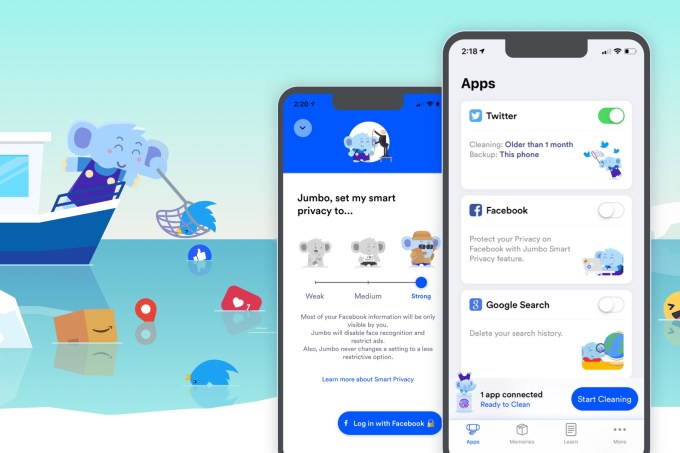
 The question is whether tech’s biggest companies will allow Jumbo to operate, or squash its access. Facebook, Twitter and the rest really should have built features like Jumbo’s themselves or made them easier to use, since they could boost people’s confidence and perception that might increase usage of their apps. But since their business models often rely on gathering and exploiting as much of your data as possible, and squeezing engagement from more widely visible content, the giants are incentivized to find excuses to block Jumbo.
The question is whether tech’s biggest companies will allow Jumbo to operate, or squash its access. Facebook, Twitter and the rest really should have built features like Jumbo’s themselves or made them easier to use, since they could boost people’s confidence and perception that might increase usage of their apps. But since their business models often rely on gathering and exploiting as much of your data as possible, and squeezing engagement from more widely visible content, the giants are incentivized to find excuses to block Jumbo.
“Privacy is something that people want, but at the same time it just takes too much time for you and me to act on it,” explains Jumbo founder Pierre Valade, who formerly built beloved high-design calendar app Sunrise that he sold to Microsoft in 2015. “So you’re left with two options: you can leave Facebook, or do nothing.”
Jumbo makes it easy enough for even the lazy to protect themselves. “I’ve used Jumbo to clean my full Twitter, and my personal feeling is: I feel lighter. On Facebook, Jumbo changed my privacy settings, and I feel safer.” Inspired by the Cambridge Analytica scandal, he believes the platforms have lost the right to steward so much of our data.
Valade’s Sunrise pedigree and plan to follow Dropbox’s bottom-up freemium strategy by launching premium subscription and enterprise features has already attracted investors to Jumbo. It’s raised a $3.5 million seed round led by Thrive Capital’s Josh Miller and Nextview Ventures’ Rob Go, who “both believe that privacy is a fundamental human right,” Valade notes. Miller sold his link-sharing app Branch to Facebook in 2014, so his investment shows those with inside knowledge see a need for Jumbo. Valade’s six-person team in New York will use the money to develop new features and try to start a privacy moment.
How Jumbo works
First let’s look at Jumbo’s Facebook settings fixes. The app asks that you punch in your username and password through a mini-browser open to Facebook instead of using the traditional Facebook Connect feature. That immediately might get Jumbo blocked, and we’ve asked Facebook if it will be allowed. Then Jumbo can adjust your privacy settings to Weak, Medium, or Strong controls, though it never makes any privacy settings looser if you’ve already tightened them.
Valade details that since there are no APIs for changing Facebook settings, Jumbo will “act as ‘you’ on Facebook’s website and tap on the buttons, as a script, to make the changes you asked Jumbo to do for you.” He says he hopes Facebook makes an API for this, though it’s more likely to see his script as against policies.
.
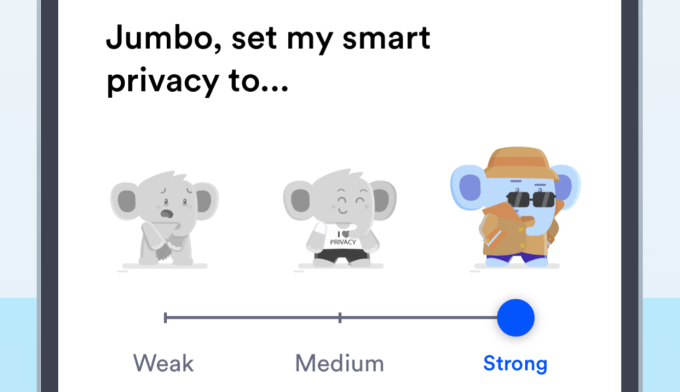
For example, Jumbo can change who can look you up using your phone number to Strong – Friends only, Medium – Friends of friends, or Weak – Jumbo doesn’t change the setting. Sometimes it takes a stronger stance. For the ability to show you ads based on contact info that advertisers have uploaded, both the Strong and Medium settings hide all ads of this type, while Weak keeps the setting as is.
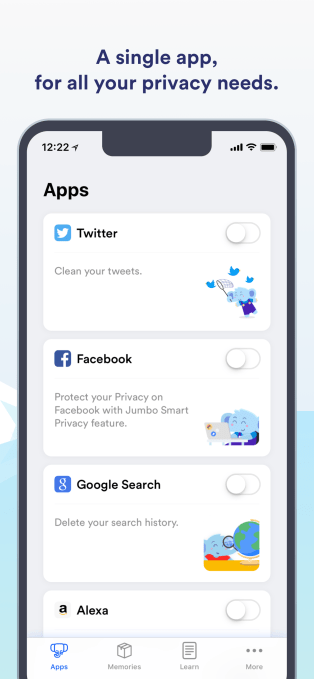
The full list of what Jumbo can adjust includes Who can see your future posts?, Who can see the people?, Pages and lists you follow, Who can see your friends list?, Who can see your sexual preference?, Do you want Facebook to be able to recognize you in photos and videos?, Who can post on your timeline?, and Review tags people add to your posts the tags appear on Facebook? The full list can be found here.
For Twitter, you can choose if you want to remove all tweets ever, or that are older than a day, week, month (recommended), or three months. Jumbo never sees the data, as everything is processed locally on your phone. Before deleting the tweets, it archives them to a Memories tab of its app. Unfortunately, there’s currently no way to export the tweets from there, but Jumbo is building Dropbox and iCloud connectivity soon, which will work retroactively to download your tweets. Twitter’s API limits mean it can only erase 3,200 tweets of yours every few days, so prolific tweeters may require several rounds.
Its other integrations are more straightforward. On Google, it deletes your search history. For Alexa, it deletes the voice recordings stored by Amazon. Next it wants to build a way to clean out your old Instagram photos and videos, and your old Tinder matches and chat threads.
Across the board, Jumbo is designed to never see any of your data. “There isn’t a server-side component that we own that processes your data in the cloud,” Valade says. Instead, everything is processed locally on your phone. That means, in theory, you don’t have to trust Jumbo with your data, just to properly alter what’s out there. The startup plans to open source some of its stack to prove it isn’t spying on you.
While there are other apps that can clean your tweets, nothing else is designed to be a full-fledged privacy assistant. Perhaps it’s a bit of idealism to think these tech giants will permit Jumbo to run as intended. Valade says he hopes if there’s enough user support, the privacy backlash would be too big if the tech giants blocked Jumbo. “If the social network blocks us, we will disable the integration in Jumbo until we can find a solution to make them work again.”
But even if it does get nixed by the platforms, Jumbo will have started a crucial conversation about how privacy should be handled offline. We’ve left control over privacy defaults to companies that earn money when we’re less protected. Now it’s time for that control to shift to the hands of the user.
Powered by WPeMatico
Watch Google Cloud Next developer conference live right here
If you can’t stop dreaming about NoSQL databases, Google’s Cloud Next conference is the closest thing to heaven that you’ll find today. At 9 AM PT, 12 PM ET, 5 PM GMT, some of the brightest minds in cloud computing are going to introduce the upcoming features of Google Cloud.
Along with Amazon Web Services and Microsoft Azure, Google is building the infrastructure of the web. Countless startups use Google Cloud as their only hosting provider. And there are now more and more specialized and niche services launching. So it’s going to be interesting to see what Google has in store to beat their competitors on the cloud front.
We’ll have a team on the ground covering all the announcements and explaining what it means.
Powered by WPeMatico
Google Cloud challenges AWS with new open-source integrations
Google today announced that it has partnered with a number of top open-source data management and analytics companies to integrate their products into its Google Cloud Platform and offer them as managed services operated by its partners. The partners here are Confluent, DataStax, Elastic, InfluxData, MongoDB, Neo4j and Redis Labs.
The idea here, Google says, is to provide users with a seamless user experience and the ability to easily leverage these open-source technologies in Google’s cloud. But there is a lot more at play here, even though Google never quite says so. That’s because Google’s move here is clearly meant to contrast its approach to open-source ecosystems with Amazon’s. It’s no secret that Amazon’s AWS cloud computing platform has a reputation for taking some of the best open-source projects and then forking those and packaging them up under its own brand, often without giving back to the original project. There are some signs that this is changing, but a number of companies have recently taken action and changed their open-source licenses to explicitly prevent this from happening.
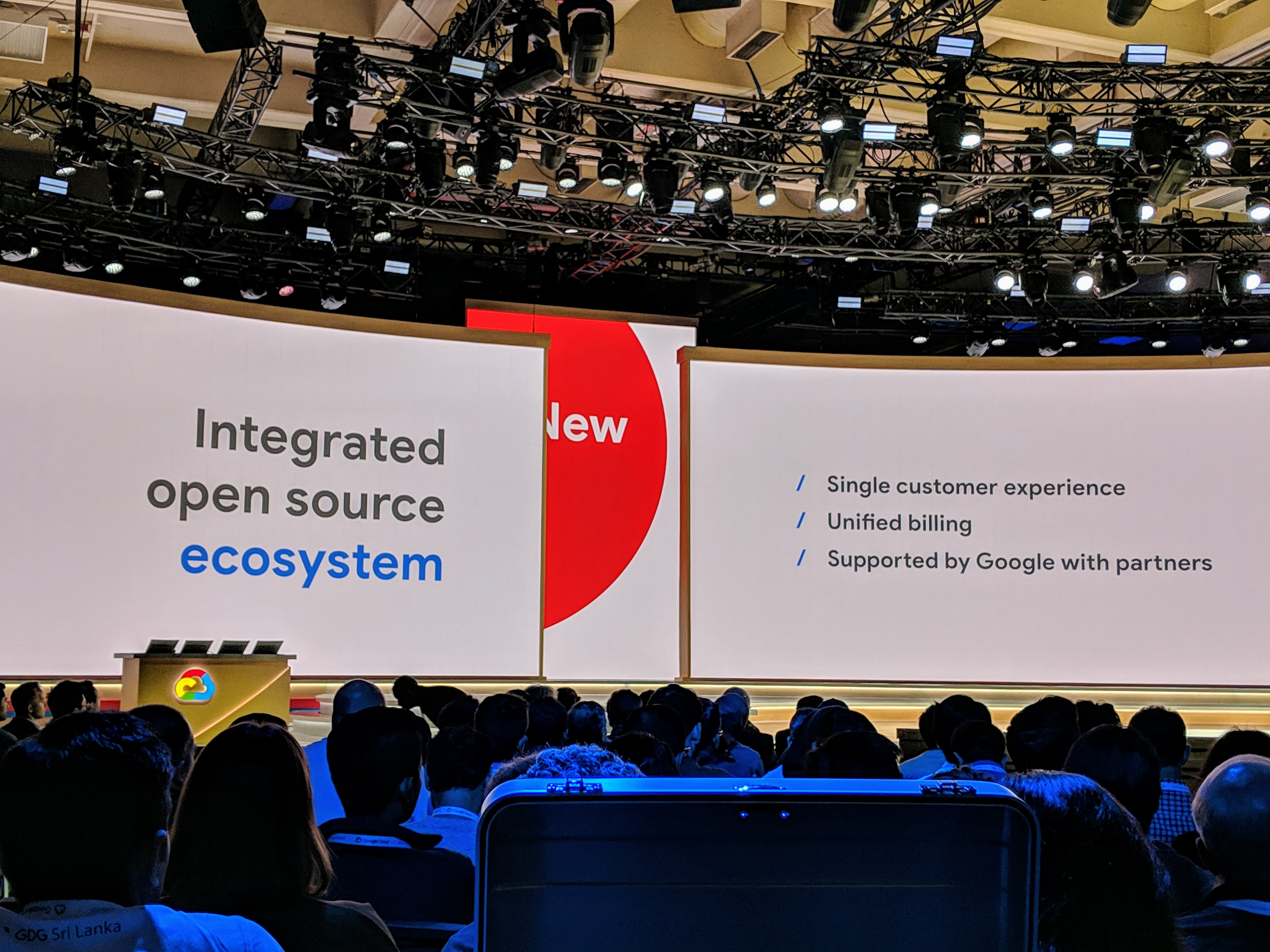
That’s where things get interesting, because those companies include Confluent, Elastic, MongoDB, Neo4j and Redis Labs — and those are all partnering with Google on this new project, though it’s worth noting that InfluxData is not taking this new licensing approach and that while DataStax uses lots of open-source technologies, its focus is very much on its enterprise edition.
“As you are aware, there has been a lot of debate in the industry about the best way of delivering these open-source technologies as services in the cloud,” Manvinder Singh, the head of infrastructure partnerships at Google Cloud, said in a press briefing. “Given Google’s DNA and the belief that we have in the open-source model, which is demonstrated by projects like Kubernetes, TensorFlow, Go and so forth, we believe the right way to solve this it to work closely together with companies that have invested their resources in developing these open-source technologies.”
So while AWS takes these projects and then makes them its own, Google has decided to partner with these companies. While Google and its partners declined to comment on the financial arrangements behind these deals, chances are we’re talking about some degree of profit-sharing here.
“Each of the major cloud players is trying to differentiate what it brings to the table for customers, and while we have a strong partnership with Microsoft and Amazon, it’s nice to see that Google has chosen to deepen its partnership with Atlas instead of launching an imitation service,” Sahir Azam, the senior VP of Cloud Products at MongoDB told me. “MongoDB and GCP have been working closely together for years, dating back to the development of Atlas on GCP in early 2017. Over the past two years running Atlas on GCP, our joint teams have developed a strong working relationship and support model for supporting our customers’ mission critical applications.”
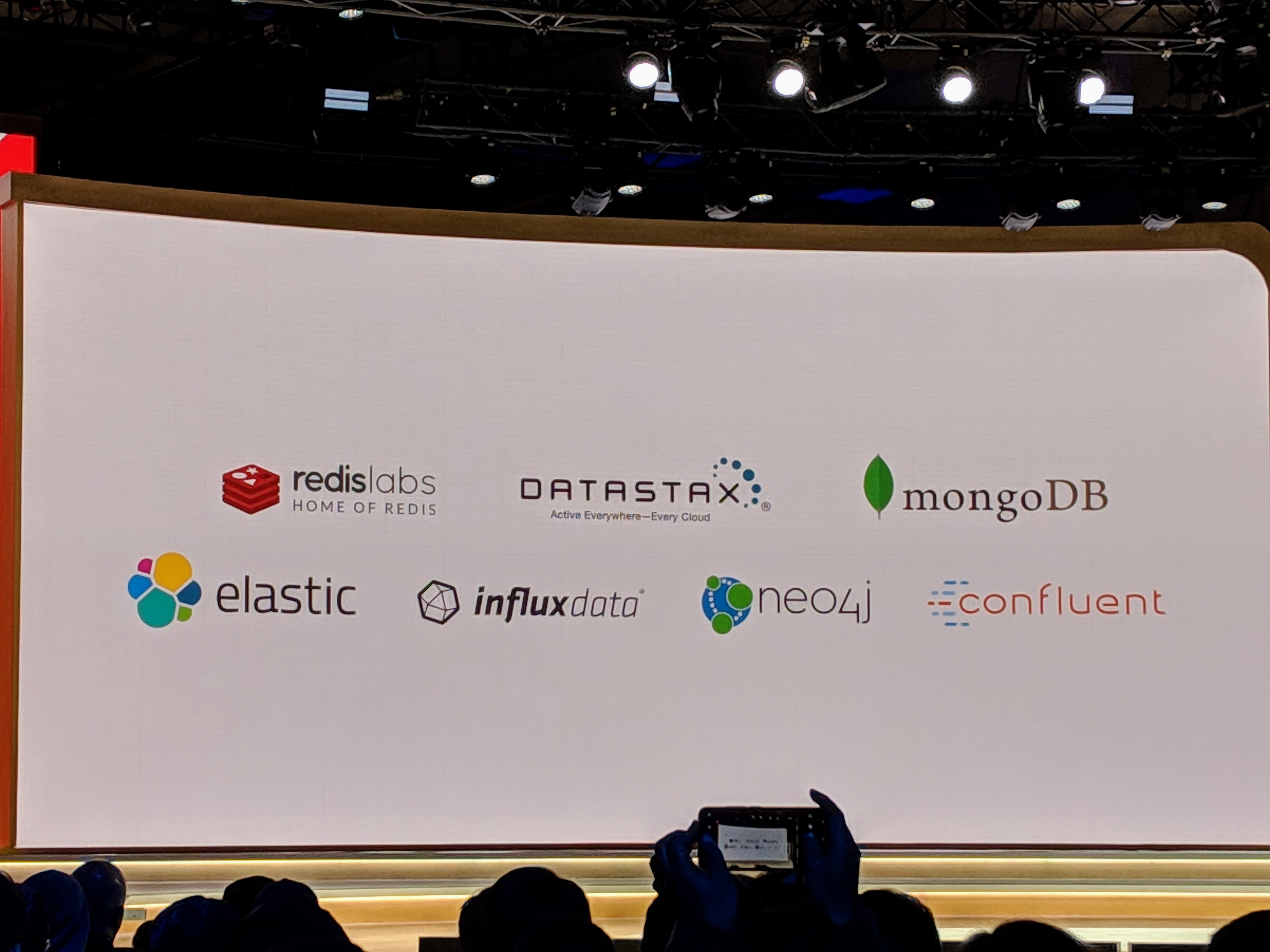
As for the actual functionality, the core principle here is that Google will deeply integrate these services into its Cloud Console; for example, similar to what Microsoft did with Databricks on Azure. These will be managed services and Google Cloud will handle the invoicing and the billings will count toward a user’s Google Cloud spending commitments. Support will also run through Google, so users can use a single service to manage and log tickets across all of these services.
Redis Labs CEO and co-founder Ofer Bengal echoed this. “Through this partnership, Redis Labs and Google Cloud are bringing these innovations to enterprise customers, while giving them the choice of where to run their workloads in the cloud, he said. “Customers now have the flexibility to develop applications with Redis Enterprise using the fully integrated managed services on GCP. This will include the ability to manage Redis Enterprise from the GCP console, provisioning, billing, support, and other deep integrations with GCP.”
Powered by WPeMatico





